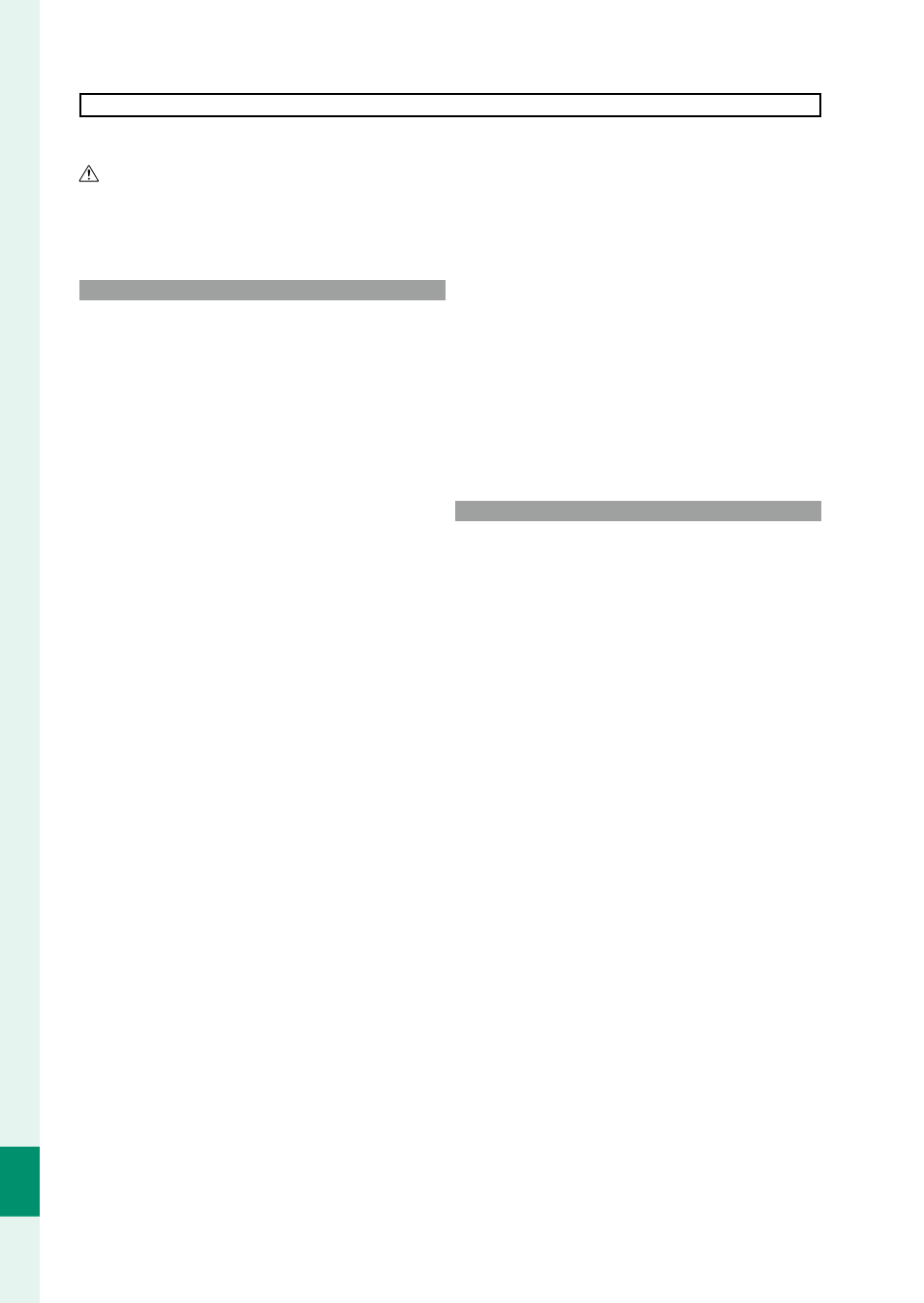FujiFilm X-H2 Mirrorless Camera User Manual
Page 374

350
T
echnical Not
es
12
The Battery and Power Supply
Note
:
Check the type of battery used in your camera and read
the appropriate sections.
WARNING
:
Battery shall not be exposed to excessive heat
such as sunshine, fire or the like.
The following describes the proper use of batteries and how
to prolong their life. Incorrect use can shorten battery life or
cause leakage, overheating, fi re, or explosion.
Li-ion Batteries
Li-ion Batteries
Read this section if your camera uses a rechargeable Li-ion
battery.
The battery is not charged at shipment. Charge the battery
before use. Keep the battery in its case when not in use.
■
■
Notes on the Battery
Notes on the Battery
The battery gradually loses its charge when not in use.
Charge the battery one or two days before use.
Battery life can be extended by turning the camera off when
not in use.
Battery capacity decreases at low temperatures; a depleted
battery may not function when cold. Keep a fully charged
spare battery in a warm place and exchange as necessary,
or keep the battery in your pocket or other warm place and
insert it in the camera only when shooting. Do not place the
battery in direct contact with hand warmers or other heating
devices.
■
■
Charging the Battery
Charging the Battery
The battery can be charged using the camera and supplied
AC adapter or an optional BC-W235 dual battery charger.
Charging times will increase at ambient temperatures below
+10 °C (+50 °F) or above +35 °C (+95 °F). Do not attempt to
charge the battery at temperatures above +40 °C (+104 °F); at
temperatures below +5 °C (+41 °F), the battery will not charge.
Do not attempt to recharge a fully charged battery. The battery
does not however need to be fully discharged before charging.
The battery may be warm to the touch immediately after
charging or use. This is normal.
■
■
Battery Life
Battery Life
A noticeable decrease in the length of time the battery will
hold a charge indicates that it has reached the end of its ser-
vice life and should be replaced.
If the battery is left for long periods without charging, you
may fi nd that its quality degrades or that it no longer holds a
charge. Charge the battery regularly.
■
■
Storage
Storage
If the camera will not be used for an extended period, store
it at room temperature with the battery charged to approxi-
mately one half to ⁄ capacity.
If the camera will not be used for an extended period, re-
move the battery and store it in a dry place with an ambient
temperature of from +15 °C to +25 °C (+59 °F to +77 °F). Do
not store in locations exposed to extremes of temperature.
■
■
Cautions: Handling the Battery
Cautions: Handling the Battery
•
Do not transport or store with metal objects such as neck-
laces or hairpins.
•
Do not expose to fl ame or heat.
•
Do not disassemble or modify.
•
Do not expose to low atmospheric pressures.
•
Use with designated chargers only.
•
Dispose of used batteries promptly.
•
Do not drop or subject to strong physical shocks.
•
Do not expose to water.
•
Keep the terminals clean.
•
The battery and camera body may become warm to the
touch after extended use. This is normal.
■
Caution
:
Disposal
Disposal
Dispose of used batteries in accord with local regulations.
Attention should be drawn to the environmental aspects of
battery disposal. Use the apparatus under moderate climate.
Do not mechanically crush or split batteries.
AC Power Adapters
AC Power Adapters
•
The AC power adapter is for indoor use only.
•
Be sure the cable is securely connected to the camera.
•
Turn the camera off before disconnecting the adapter. Dis-
connect the adapter by the plug, not the cable.
•
Do not disassemble.
•
Do not expose to high heat and humidity.
•
Do not subject to strong physical shocks.
•
The adapter may hum or become hot to the touch during
use. This is normal.
•
If the adapter causes radio interference, reorient or relocate
the receiving antenna.
